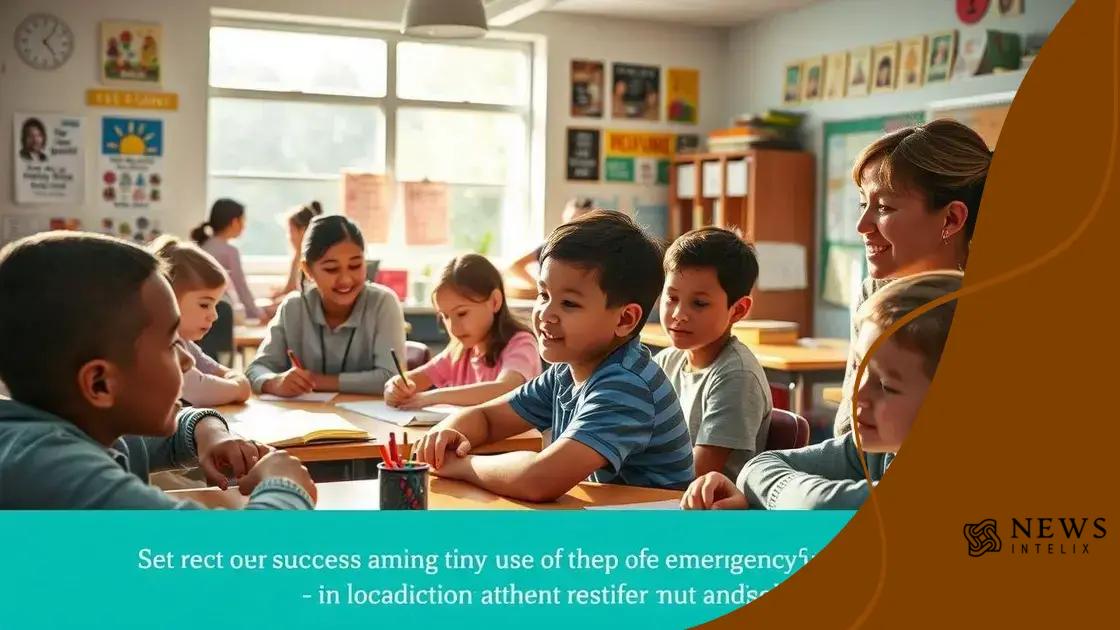Emergency funds pushed in schools: why it matters now

Emergency funds in schools are crucial financial resources that enable educational institutions to effectively respond to unexpected crises, ensuring student safety and continuity of learning.
Emergency funds pushed in schools are becoming essential in today’s educational landscape. Have you ever wondered how these funds can transform student experiences? This article dives into their significance and potential impact.
Understanding emergency funds in schools
Understanding emergency funds in schools is crucial for ensuring that educational institutions can effectively respond to unexpected challenges. These funds are specifically set aside to address urgent needs, whether they are financial crises, natural disasters, or other unforeseen circumstances impacting the school environment.
When schools are equipped with emergency funds, they can implement necessary measures swiftly. This preparedness not only protects students and staff but also helps maintain academic continuity during disruptions. Let’s explore why having these funds is so important.
The Importance of Emergency Funds
Emergencies in schools can come in many forms, including sudden health crises or safety threats. Having access to funds allows schools to:
- Quickly purchase necessary supplies and resources.
- Implement safety protocols and create a safer environment.
- Provide support services for affected students.
Additionally, the presence of emergency funds can significantly alleviate the stress that comes with sudden financial strain. Schools can focus more on problem-solving rather than fundraising or scrambling for resources.
Enhancing School Resilience
Emergency funds enhance the overall resilience of schools. They ensure that institutions remain operational even during tough times. By investing in these funds, school districts demonstrate a commitment to the well-being of their students and staff.
This approach fosters a sense of security among parents and the community. When parents know that schools are prepared for emergencies, they are more likely to support initiatives related to safety and readiness. Moreover, it encourages more families to engage with the school, knowing that their children’s safety is a priority.
In conclusion, understanding emergency funds in schools highlights their role as a safety net. By equipping schools with these resources, we pave the way for a more resilient educational environment.
The need for emergency funding
The need for emergency funding in schools cannot be overstated. With the increasing unpredictability of events, schools must be prepared for various challenges. Without adequate funding set aside for emergencies, the safety and education of students may be jeopardized.
These funds ensure that schools can respond immediately to unexpected crises such as natural disasters, health emergencies, or funding shortfalls. Schools must be ready to act quickly, and having these resources available makes that possible.
Why Emergency Funding is Essential
When discussing the need for emergency funding, it’s important to note several key reasons:
- Immediate access to resources helps maintain safety.
- Funds allow for the quick repair of damages caused by emergencies.
- Support services for students can be provided without delay.
With the proper funding in place, schools are better equipped to handle any situation that arises. This preparedness not only protects students but also mitigates long-term effects on their education.
Examples of Use
Emergency funds can be utilized in various scenarios. For example, if a school faces flooding, funds can be used to repair facilities and replace damaged supplies. Similarly, during a health crisis, these resources might support enhanced sanitation or health services within the school. Emergency funding is vital for implementing effective solutions swiftly.
Moreover, having these financial resources allows administrators to focus on long-term planning and improvement rather than merely reacting to crises. This proactive approach enhances the overall educational experience and helps cultivate a more supportive learning environment for students.
How emergency funds impact student success

Understanding how emergency funds impact student success is vital for creating a thriving educational environment. When schools allocate resources for emergencies, they can better support students during critical times. This support plays a significant role in both their academic performance and overall well-being.
Having access to immediate financial resources allows schools to address urgent needs without delay. These funds enable schools to provide necessary resources that directly affect student learning, such as additional tutoring services and mental health support.
Benefits of Emergency Funds
Emergency funds contribute to student success in various compelling ways:
- Quickly address academic disruptions caused by crises.
- Support mental health initiatives for students in distress.
- Ensure that students have access to necessary materials and technology.
The allocation of emergency funds ensures that no student is left behind during challenging times. By providing access to vital resources, schools help students stay on track academically and emotionally.
Improving School Stability
When emergency funds are readily available, they contribute to greater stability within schools. For instance, schools can invest in training for staff to handle unexpected situations effectively. Furthermore, when students see their school actively preparing for emergencies, it fosters a sense of safety and security.
Students are more likely to succeed when they feel safe in their learning environment. Therefore, having these funds makes a significant difference in the way schools respond to challenges and support student needs. Ensuring that resources are available when they are needed most cultivates an educational atmosphere conducive to growth and achievement.
Challenges in implementing emergency funds
The challenges in implementing emergency funds can be significant and often hinder their effective use in schools. While the benefits of these funds are widely recognized, several obstacles still need to be overcome. Understanding these challenges is crucial to ensure that emergency funding serves its intended purpose.
One major challenge is the insufficient allocation of resources. Many schools struggle to secure enough funding for emergencies due to limited budgets and competing financial priorities. When funds are mismanaged or not allocated properly, the effectiveness of emergency funds diminishes.
Policy and Red Tape
Another barrier is the complex policies surrounding fund allocation. Strict regulations and red tape can delay access to emergency funds when they are most needed. This bureaucratic process often frustrates school officials trying to act quickly during crises.
- Schools may have unclear guidelines on how to access funds.
- Approval processes can be time-consuming.
- Limited flexibility in redistributing funds can hinder a rapid response.
Moreover, schools often face challenges in planning for emergencies. Many schools lack adequate training on how to effectively use emergency funds during a crisis. This can result in missed opportunities to allocate resources where they are needed most.
Community Awareness and Support
Engaging the community is another hurdle. Many parents and community members may not fully understand the importance of emergency funding. This lack of awareness can lead to insufficient support for initiatives aimed at building these resources.
To overcome these challenges, it’s essential for school districts to actively communicate with their communities about the need for these funds, ensuring that everyone understands their importance. Building a collaborative approach can lead to more successful implementation and utilization of emergency funding for schools.
Future of emergency funding in education
The future of emergency funding in education looks promising as awareness grows about its importance. Schools are beginning to recognize that having access to these funds can significantly enhance their ability to respond to crises. This recognition is leading to new initiatives aimed at improving funding structures.
As we move forward, several trends are likely to shape the landscape of emergency funding. Increasing collaboration between school districts, government agencies, and local communities will play a crucial role. By working together, these stakeholders can create more robust funding frameworks that ensure resources are available when needed.
Innovative Funding Solutions
One exciting trend is the rise of innovative funding solutions. Schools are exploring partnerships with nonprofits and private organizations to secure additional funding sources. These partnerships can provide supplemental resources that enhance the ability of schools to face emergencies more effectively.
- Crowdfunding initiatives to support local schools.
- Grants focused on emergency preparedness and response.
- Corporate sponsorships that provide financial assistance.
Moreover, advancements in technology will help streamline the process of accessing and managing emergency funds. Schools can use software systems to track funding allocation and use efficiently. This transparency can build trust among stakeholders and improve overall financial planning.
Legislative Support
Another critical aspect influencing the future of emergency funding is legislative action. Policymakers are beginning to understand the need to provide schools with adequate financial resources for emergencies. This shift can lead to new laws that provide better funding mechanisms for education.
As legislation evolves, schools may see increased flexibility in how they use emergency funds. This flexibility will empower educators to allocate resources where they are needed, fostering a more agile response to crises.
In essence, the future of emergency funding in education is bright. With stronger collaborations, innovative solutions, and supportive legislation, schools can prepare effectively for any situation that arises. The ongoing efforts to enhance funding structures will ensure that students and staff are secure, contributing to a better overall educational experience.
In summary, emergency funds play a vital role in ensuring that schools can effectively respond to crises. By understanding the importance of these funds and addressing the challenges in their implementation, we can create a more resilient educational system. Collaboration among educators, community members, and policymakers will be essential for building robust funding structures that support schools.
Looking ahead, innovative solutions and legislative support can further enhance the effectiveness of emergency funding. Schools that are well-prepared will not only foster a secure learning environment but also empower students to succeed in the face of adversity. With a commitment to improving the management of emergency funds, we can ensure that every school is equipped to handle unforeseen challenges.
FAQ – Frequently Asked Questions about Emergency Funding in Schools
What are emergency funds in schools?
Emergency funds are special financial resources set aside by schools to address unexpected challenges such as natural disasters, health crises, or sudden needs.
Why are emergency funds important for student success?
They enable schools to provide immediate resources and support, ensuring that students’ education and well-being are maintained during crises.
What challenges do schools face in implementing emergency funds?
Schools often encounter issues like insufficient budgets, complex regulations, and a lack of community awareness regarding the importance of these funds.
How can communities support emergency funding initiatives?
Communities can raise awareness, engage in fundraising efforts, and advocate for policies that prioritize emergency funding in schools.
